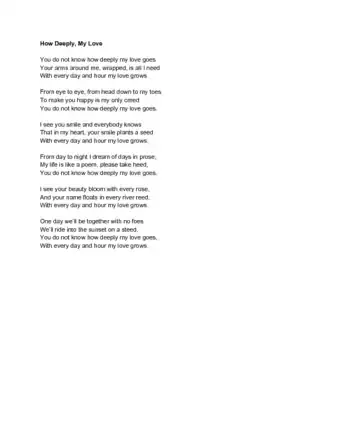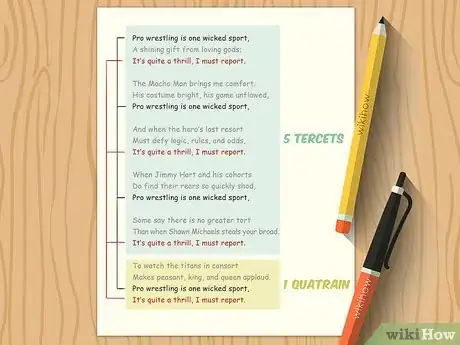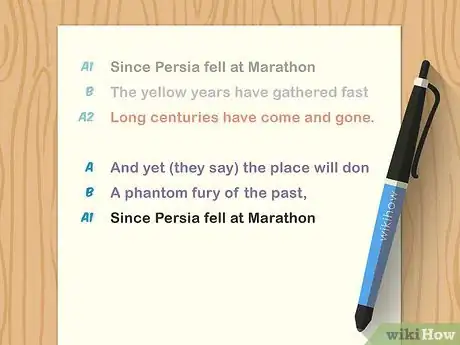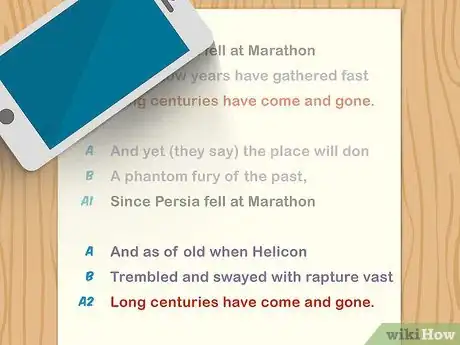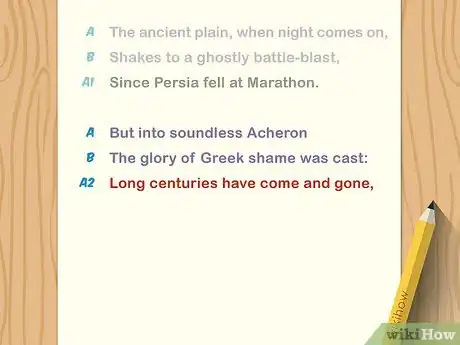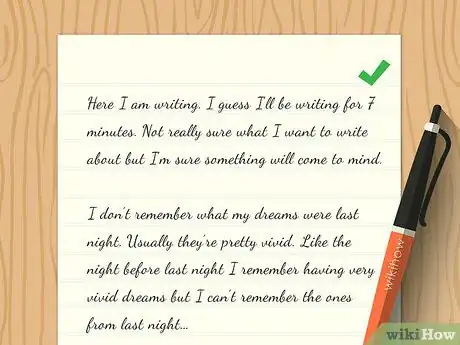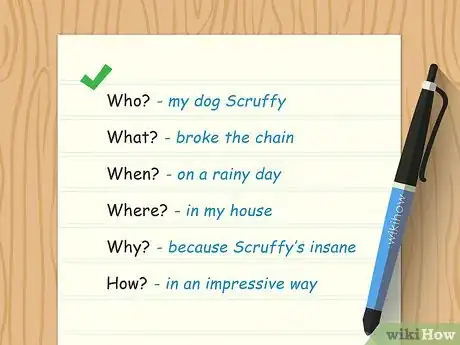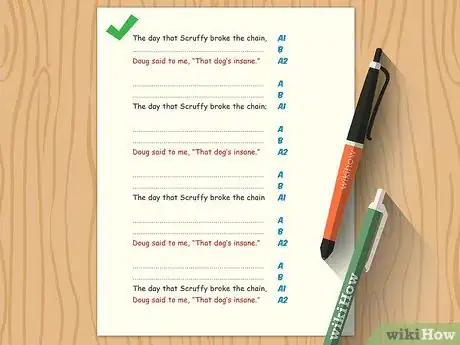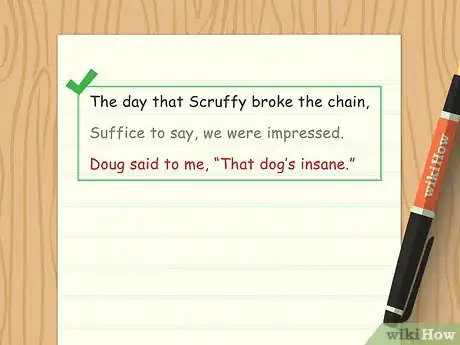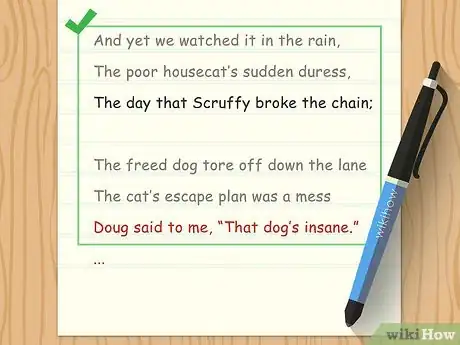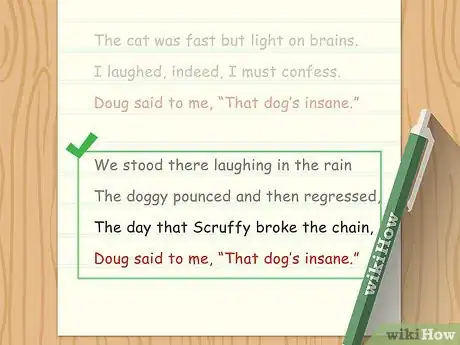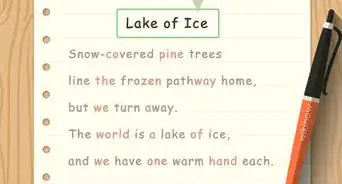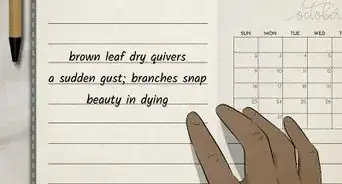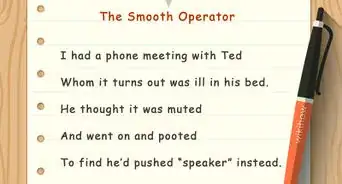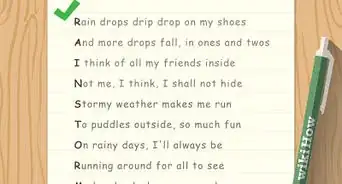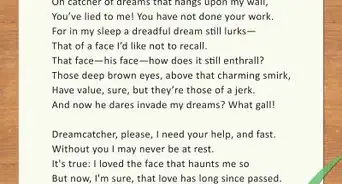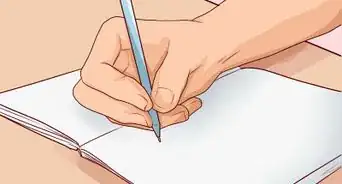This article was co-authored by Megan Morgan, PhD. Megan Morgan is a Graduate Program Academic Advisor in the School of Public & International Affairs at the University of Georgia. She earned her PhD in English from the University of Georgia in 2015.
There are 10 references cited in this article, which can be found at the bottom of the page.
wikiHow marks an article as reader-approved once it receives enough positive feedback. In this case, 85% of readers who voted found the article helpful, earning it our reader-approved status.
This article has been viewed 391,857 times.
The word “villanelle” or “villainesque” was used toward the end of the 16th century to describe literary imitations of rustic songs. The villanelle originated as a dance song with a loose structure in Italy and Spain.[1] The villanelle developed into a highly structured poem with a rigid rhyme scheme. The form was popular with English and French poets, and many contemporary poets have loosened up the structure of the villanelle to allow for variations and shifts in the form.
Steps
Sample Villanelles
Understanding the Form
-
1Learn the rules of a villanelle. The villanelle has 19 lines, split into 5 tercets (three-line stanzas) and 1 quatrain (a stanza of 4 lines). There are two repeating rhymes and two "refrains," or repeated lines.[2]
- The 1st and 3rd lines alternate as the last lines of stanzas 2, 3, and 4. The last stanza uses the 1st and 3rd lines as a rhymed couplet. If we use capitals for the refrains and lowercase letters for the rhymes, the form could be expressed as: A1 b A2 / a b A1 / a b A2 / a b A1 / a b A2 / a b A1 A2.[3]
- There is no set meter in a villanelle but there is a set rhyme scheme. There is no fixed number of syllables for each line in a villanelle.[4]
- The villanelle is broken into three parts: the introduction, the development, and the conclusion. Most villanelles build up intensity and tone until they reach the conclusion.[5]
-
2Look at the structure. The easiest way to do this is to break down a villanelle line by line, such as "Villanelle of Change" by Edward Arlington Robinson.[6] Let's look at the first stanza of the poem:
- line A1- first refrain - Since Persia fell at Marathon
- line b - The yellow years have gathered fast
- line A2 - second refrain - Long centuries have come and gone.
Advertisement -
3Note the second stanza of the poem. The second stanza will use the same first refrain, but line "b" line will be different. The line "a" will rhyme with the first refrain, "A1". The line "b" will rhyme with line "b" in the first stanza.[7]
- line a - And yet (they say) the place will don
- line b - A phantom fury of the past,
- line A1 - Since Persia fell at Marathon;
-
4Look at the third stanza of the poem. The third stanza will use the same second refrain. Line "a" will rhyme with the second refrain, "A2". Line "b" will rhyme with line "b" in the previous stanza.[8]
- line a - And as of old when Helicon
- line b - Trembled and swayed with rapture vast
- line A2 - (Long centuries have come and gone),
-
5Note the fourth stanza of the poem. The fourth stanza will use the same first refrain, “A1”. Line “a” will rhyme with the first refrain. Line “b” will rhyme with the line “b” in the previous stanza.[9]
- line 10 - a - The ancient plain, when night comes on,
- line 11 - b - Shakes to a ghostly battle-blast,
- line 12 - A1 - Since Persia fell at Marathon.
-
6Look at the fifth stanza of the poem. The fifth stanza will use the same second refrain. Line "a" will rhyme with the second refrain, "A2". Line "b" will rhyme with line "b" in the previous stanza.[10]
- line 13 - a - But into soundless Acheron
- line 14 - b - The glory of Greek shame was cast:
- line 15 - A2 - Long centuries have come and gone,
-
7Note the sixth and final stanza of the poem. Line “a” will rhyme with the first refrain, “A1”. Line “b” will rhyme with the line “b” in the previous stanza. The poem then ends with the first refrain, “A1” and the second refrain, “A2”.[11]
- line 16 - a - The suns of Hellas have all shone,
- line 17 - b - The first has fallen to the last;--
- line 18 - A1 - Since Persia fell at Marathon,
- line 19 - A2 - Long centuries have come and gone.
-
8Read examples of the villanelle. There are several well known examples of the form, where the use of the refrain becomes a powerful way to underscore or undercut the previous lines in the stanza.[12] For example:
- Dylan Thomas' "Do Not Go Gentle Into that Good Night"[13] is one of the most famous examples of the villanelle form. Thomas’ poem uses the villanelle structure to deepen the meaning of each stanza.
- Elizabeth Bishop's "One Art" includes text in parenthesis and dashes. Bishop also does a variation on the refrain lines that deviates from the form and from the traditional rhyme scheme of the villanelle.
- Sylvia Plath’s "Mad Girl’s Love Song" puts a more contemporary spin on the form.
-
9Analyze the examples. Look critically at two villanelle examples. Use the examples to decide how to structure your villanelle.
- What will the tone of your villanelle be? More song-like and lyrical? Or more casual and direct? For example, Thomas’ "Do Not Go Gentle Into that Good Night" uses verbs like “burn,” “rave,” and “rage” and has a rhyming quality that flows when read out loud. In contrast, Plath’s "Mad Girl’s Love Song" uses plainer language like “shut,” “lift,” “and “made up”.
- Will your villanelle use a direct address? Plath’s poem has an “I” speaker throughout the poem that addresses the reader. Thomas’ poem does not have an “I” speaker. Instead, the poem uses a “you” to suggest the poem is being told to another person, such as the speaker’s father.
- How will you use the refrain in each stanza of your villanelle? Will the refrains deepen the meaning of the previous lines? Contradict the meaning? In Thomas’ poem, the refrains reinforce the overall theme of the villanelle, urging the speaker’s father to “rage, rage against the dying of the light.” In Bishop’s "One Art," Bishop rephrases the refrain lines. Rather than have freestanding phrases as refrain lines, Bishop uses line breaks to create refrains. “...to be lost that their loss is no disaster” in the first stanza is then rephrased as “None of these will bring disaster” in the third stanza, and then is rephrased again in the fifth stanza as: “I miss them but it wasn’t a disaster.”
-
10Think about how to create an introduction, a section of development, and a conclusion in your villanelle. This is the general pattern of the villanelle.[14] Bishop’s poem is a good example of an effective structure, as it begins with a claim: “The art of losing isn’t hard to master” as its introduction.
- The poem then develops this claim or idea in the middle section, “Lose something every day,” “I lost my mother’s watch.” The poem builds up to a conclusion by discussing bigger and bigger things the speaker loses, from her mother’s watch to “three loved houses” to “two cities” to “a continent.”
- The conclusion in the last stanza then reveals the speaker also lost a “you,” a lover perhaps or a friend, and the speaker has to admit (“Write it!") that it is a disaster.
Brainstorming Your Villanelle
-
1Create an association diagram. An association diagram is also known as a clustering technique. You will create a cluster or group of words around a theme or idea.[15]
- Take out a sheet of paper. Write your main topic or subject in the middle of the paper. For example, “a leopard.”
- Moving out from the center, write down other words that pop into your mind that relate back to “a leopard.” You can also draw a circle or box around the main topic and use little lines to connect the other words to the main topic.
- For example, for “a leopard,” you might write “predator,” “wild,” “jaws,” “spotted”. Don’t worry about organizing the words as you write. Simply let the words flow around the main topic.
- Once you feel you have written enough words around the main topic, start to cluster the words. Draw a circle around words that relate to each other and draw a line between the circled words to connect them. Continue doing this with the other words. Some of the terms may end up uncircled, but these lone words can still be useful.
- Focus on how the words relate back to the main topic. If you have clustered together several words that relate to “predator,” for example, maybe this may be a good approach for the poem. Or if there are a lot of clustered words that focus on “teeth”, this may be another way to approach “a leopard.”
- Answer questions like: “I was surprised by…” or “I discovered…” For example, you may look over the clustered words and note “I was surprised by how often I mention my brother in relation to a leopard.” Or, “I discovered I may want to write about how a leopard means a wild or strong personality or character, like my brother.”
-
2Do a freewrite. A freewrite is a chance for you to let your thoughts flow on a piece of paper. Write whatever comes into your mind and don’t judge or worry about what you are writing.[16]
- Take out a piece of paper, or open a new document on your computer. Write the main topic at the top of the paper. Then, set a time limit of 10 minutes and start the freewrite.[17]
- A good rule of thumb for the freewrite is to not lift your pen from the paper, or your fingers from the keyboard. This means not re-reading the sentences you just wrote or going back over a line for spelling, grammar, or punctuation. If you feel you have run out of things to write down, write about your frustrations about not having anything else to say about the main topic.
- Stop writing once the timer is up. Read over the text. Though there may be some confusing or convoluted thoughts, there will also be sentences you may like or an insight that may be useful.
- Highlight or underline sentences or phrases you think may work in the villanelle.
-
3Ask the six big questions. Take out a sheet of paper or open a new document. Write the main topic of the vignette on the top of the document. Then, write down six headings: Who? What? When? Where? Why? and How?[18]
- Respond to each question with a phrase or sentence. For example, if your topic is “a leopard,” you may answer Who? with “my brother and I.” You may answer When? with “A hot summer day in July when I was six years old.” You may answer Where? with “the San Diego Zoo.” You may answer Why? with “Because my brother loved watching the leopard at the zoo and later became a strong personality as an adult.” And you may answer How? with “He grew up to be an angry man who is misunderstood by many people, including me.”
- Look over your responses. Do you have more than one or two phrases for a certain question? Is there one question you had no answer for? If your answers reveal you know more about “where” and “why,” maybe this is where the strongest ideas for the villanelle are.
-
4Make two lists of words that rhyme. A key element of a villanelle is the rhyme scheme. Using the words and phrases you have written down in your brainstorm, create two lists of words that correspond with each other and rhyme. If you can think of phrases that end in rhyming words, write those down as well.
- Think about creating refrains that will help you build intensity in the poem. Avoid closed sentences that simply state the obvious, like “We were at the zoo” or “I was six.”
- For example, you may write down “leopard” and “shepherd,” or “cage” and “age” and “rage.”
- Or you may write down phrases like: “the leopard paced around the cage” and “my brother and I didn’t understand at that age.”
- Think about creating detailed descriptions and detailed internal reflections or thoughts with the rhyming words in your list. Go for words that are easy to rhyme with, such as “son,” “zoo,” or “age,” rather than words that are very difficult to use in a rhyme, like “orange.”
- You can use a thesaurus to help you. You can purchase them from bookstores or find free ones online.
Writing the Villanelle
-
1Compose the first and second refrains. Once you’ve brainstormed and compiled a list of rhyming words or phrases, create the first and second refrains. These refrains should be meaningful to the poem, and should allow you to give them more meaning with each repetition.[19]
- To do this, you could place several rhyming words you like on two different lines and try to write sentences that work around these words. Remember that the refrains need to end with the rhyming words.
- You could also rearrange phrases you have written down to incorporate rhyming words at the end of the phrases. For example: “In the cage, the leopard paced” could be rephrased as: “The leopard paced around the metal cage” to then rhyme with “My brother and I didn’t understand at that age.”
-
2Place the refrains in the structure of the villanelle. One of the easiest ways to work within the structure of the villanelle is to establish the refraining lines first and then work around them. On a piece of paper or a word-processing document, place the refrains within the form of the villanelle.
- They should appear as A1 and A2 in the order: A1 b A2 / a b A1 / a b A2 / a b A1 / a b A2 / a b A1 A2.
- So, if your first refrain is “The leopard paced around the metal cage,” and your second refrain is “My brother and I didn’t understand at that age,” place them in the A1 and A2 lines of your villanelle.
-
3Create an introduction. Now that you have the refrains down, start filling in the first stanza. This is the introduction segment of the poem, so decide how you want to introduce your subject, theme, or idea to the reader.
- If you are describing a certain memory or moment, start by setting the scene. Such as: “I was six when my brother and I saw a leopard at the San Diego Zoo.”
- If you are writing the poem as a direct address to someone else, such as your brother, you could begin by discussing the last time you saw or spoke to this person. For example: “You were dressed in black at the funeral.” Or, you can use a line that doesn’t use a “you,” similar to Dylan Thomas’ poem, such as: “Don’t become like the leopard, don’t end up in a cage.”
-
4Develop the middle section of the poem. The middle section should develop the subject, theme, or idea in the introduction. You have four stanzas to develop the poem and push the intensity of the poem.
- One way of building intensity is to have each stanza contain larger and larger moments. For example, in Bishop’s "One Art," she goes from seemingly minor losses, like her mother’s glasses, to the loss of houses, cities, and a continent. Think about the bigger or more absurd versions of your subject or theme. For a poem about a trip to the zoo, you could describe the other animals you saw at the zoo and then build intensity by describing the leopard in the fourth stanza. Or you could describe memories of your brother, moving from smaller moments of anger to larger moments of anger.
- Another way of building intensity is to have each stanza contain different descriptions of the subject or theme. In Thomas’ poem, the speaker discusses different descriptions of “men” in the middle stanzas, the “Good men”, the “Wild men”, and the “Grave men”. In each stanza, Thomas describes each type of man’s approach to death or the “dying of the light”.[20]
-
5Write a conclusion section. Maybe the most difficult section of a villanelle is the concluding section, or stanza. You will need to compose a meaningful ending that ties in the two refraining lines in a powerful way. Consider how you have built intensity in your villanelle so far. Don’t be afraid to address the reader or a “you” in the last stanza. You can also home in on a specific phrase or image you feel is strong and meaningful.
- Is there a way you can complicate the beginning and middle section of the poem in the ending stanza? In Thomas’ villanelle, for example, the last stanza introduces the father character, as the speaker addresses a “you”. “And you, my father, there on the sad height, / Curse, bless, me now with your fierce tears, I pray.”
- The poem gives the reader different images of “men” in the middle section and the speaker is now considering what type of man his father is in the last stanza. By bringing in the “you” in the last stanza, Thomas makes the poem very personal and specific. It also makes the last stanza very powerful.
- The best last stanzas in a poem will leave the reader with more questions than answers. In Thomas’ poem, it is not clear if his father is a man who will “go gentle into that good night.” But the speaker in the poem asks the question and argues against his father succumbing to death. In a larger sense, the last stanza could also be seen as a plea to all fathers or “men” in the world to “rage, rage against the dying of the light.”
- The last stanza in Plath’s villanelle takes a different approach than Thomas’ poem or Bishop’s poem. Rather than introduce a “you”, the speaker notes how the “I” was abandoned by a lover who did not return.
- But the refrain has a double meaning at the end of the poem, as the reader is not sure if in fact the speaker did make up the lover in her head or if the speaker just thinks she made up the lover in her head. The question of how mad the “mad girl” of the speaker is in the poem is left for the reader to decide.[21]
-
6Read the villanelle out loud. Traditionally, villanelles were written to be read out loud. Continue this tradition by reading the villanelle in your own voice to yourself or to a friend.
- This will help you note if your rhyme scheme is off or if the rhythm of the lines of the poem flow well together.
- Revise and edit the villanelle as necessary until it almost has a song-like quality.
References
- ↑ http://www.poets.org/poetsorg/text/poetic-form-villanelle
- ↑ https://poetry.arizona.edu/education/curriculum/villanelle-writing-prompt
- ↑ http://www.poets.org/poetsorg/text/poetic-form-villanelle
- ↑ http://literarydevices.net/villanelle/
- ↑ http://literarydevices.net/villanelle/
- ↑ http://www.poetryfoundation.org/poem/174251
- ↑ https://classicalpoets.org/2016/10/19/how-to-write-a-villanelle-with-examples/
- ↑ https://classicalpoets.org/2016/10/19/how-to-write-a-villanelle-with-examples/
- ↑ https://classicalpoets.org/2016/10/19/how-to-write-a-villanelle-with-examples/
- ↑ https://classicalpoets.org/2016/10/19/how-to-write-a-villanelle-with-examples/
- ↑ https://classicalpoets.org/2016/10/19/how-to-write-a-villanelle-with-examples/
- ↑ https://examples.yourdictionary.com/villanelle-examples.html
- ↑ http://www.poets.org/poetsorg/poem/do-not-go-gentle-good-night
- ↑ https://examples.yourdictionary.com/villanelle-examples.html
- ↑ http://writingcenter.unc.edu/handouts/brainstorming/
- ↑ https://www.lynchburg.edu/academics/writing-center/wilmer-writing-center-online-writing-lab/drafting-a-document/freewriting-techniques/
- ↑ http://writingcenter.unc.edu/handouts/brainstorming/
- ↑ http://writingcenter.unc.edu/handouts/brainstorming/
- ↑ https://literarydevices.com/villanelle/
- ↑ http://www.poets.org/poetsorg/poem/do-not-go-gentle-good-night
- ↑ http://literarydevices.net/villanelle/
About This Article
To write a villanelle, start by writing two refrains that will be repeated throughout the poem, which capture the meaning and tone of the poem. Next, place the refraining lines in the structure of the villanelle first, then add additional lines around them. In the first stanza, use the line between the first and second refrain to introduce the subject to the reader. In the middle stanzas, develop the theme or story further to build intensity. Finally, conclude the poem in the last stanza by honing in on a particularly meaningful symbol. For advice from our English reviewer on how to brainstorm topics for your villanelle, read on!
